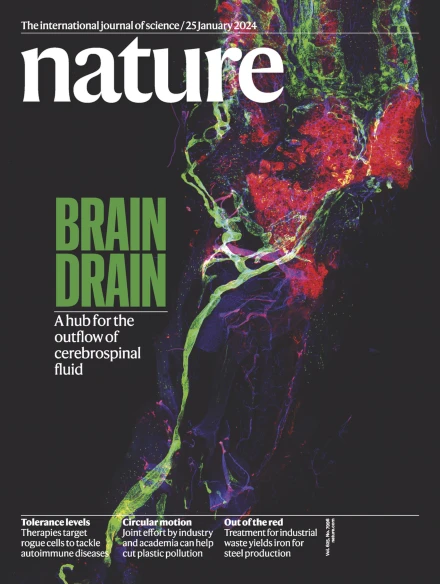Brain implantation of soft bioelectronics via embryonic development
IF 50.5
1区 综合性期刊
Q1 MULTIDISCIPLINARY SCIENCES
引用次数: 0
Abstract
Developing bioelectronics capable of stably tracking brain-wide, single-cell, millisecond-resolved neural activity in the developing brain is critical for advancing neuroscience and understanding neurodevelopmental disorders. During development, the three-dimensional structure of the vertebrate brain arises from a two-dimensional neural plate1,2. These large morphological changes have previously posed a challenge for implantable bioelectronics to reliably track neural activity throughout brain development3–9. Here we introduce a tissue-level-soft, submicrometre-thick mesh microelectrode array that integrates into the embryonic neural plate by leveraging the tissue’s natural two-dimensional-to-three-dimensional reconfiguration. As organogenesis progresses, the mesh deforms, stretches and distributes throughout the brain, seamlessly integrating with neural tissue. Immunostaining, gene expression analysis and behavioural testing confirm no adverse effects on brain development or function. This embedded electrode array enables long-term, stable mapping of how single-neuron activity and population dynamics emerge and evolve during brain development. In axolotl models, it not only records neural electrical activity during regeneration but also modulates the process through electrical stimulation. A soft mesh microelectrode array can seamlessly integrate in developing brains, enabling long-term, stable mapping of how single-neuron activity and population dynamics emerge and evolve during brain development.


通过胚胎发育的软性生物电子学脑植入
发展生物电子学,能够稳定地跟踪大脑发育过程中全脑范围、单细胞、毫秒级的神经活动,对于推进神经科学和理解神经发育障碍至关重要。在发育过程中,脊椎动物大脑的三维结构是由二维神经板形成的。这些巨大的形态学变化对植入式生物电子学在整个大脑发育过程中可靠地跟踪神经活动提出了挑战3,4,5,6,7,8,9。在这里,我们介绍了一种组织级软的,亚微米厚的网状微电极阵列,通过利用组织的自然二维到三维重构,集成到胚胎神经板中。随着器官发生的进展,网状结构会变形、伸展并分布在整个大脑中,与神经组织无缝结合。免疫染色、基因表达分析和行为测试证实对大脑发育或功能没有不良影响。这种嵌入式电极阵列能够长期稳定地绘制单个神经元活动和种群动态在大脑发育过程中如何出现和进化。在蝾螈模型中,它不仅记录了再生过程中的神经电活动,而且还通过电刺激调节了这一过程。
本文章由计算机程序翻译,如有差异,请以英文原文为准。
求助全文
约1分钟内获得全文
求助全文
来源期刊

Nature
综合性期刊-综合性期刊
CiteScore
90.00
自引率
1.20%
发文量
3652
审稿时长
3 months
期刊介绍:
Nature is a prestigious international journal that publishes peer-reviewed research in various scientific and technological fields. The selection of articles is based on criteria such as originality, importance, interdisciplinary relevance, timeliness, accessibility, elegance, and surprising conclusions. In addition to showcasing significant scientific advances, Nature delivers rapid, authoritative, insightful news, and interpretation of current and upcoming trends impacting science, scientists, and the broader public. The journal serves a dual purpose: firstly, to promptly share noteworthy scientific advances and foster discussions among scientists, and secondly, to ensure the swift dissemination of scientific results globally, emphasizing their significance for knowledge, culture, and daily life.
 求助内容:
求助内容: 应助结果提醒方式:
应助结果提醒方式:


